2014 年专业英语八级考试真题及答案
on someone
,
MINI-LECTURE
LISTENING COMPREHENSION (35 MIN)
PART I
SECTION A
In this section you will hear a mini-lecture. You will hear the lecture ONCE ONLY. While
listening, take notes on the important points. Your notes will not be marked, but you will
need them to complete a gap-filling task after the mini-lecture. When the lecture is over,
you will be given two minutes to check your notes, and another ten minutes to complete the
gap-filling task on ANSWER SHEET ONE, using no more than three words in each gap. Make sure
the word(s) you fill in is (are) both grammatically and semantically acceptable. You may refer
to your notes while completing the task Use the blank sheet for note-taking.
Now, listen to the mini-lecture.
How to Reduce Stress
Life is full of things that cause us sress. Though we may not like
stress, we have to live with it.
I. Definition of stress
A. (1)
i.e.force exerted between two touching bodies
B. human reaction
i.e. response to (2)
e.g. increase in breathing, heart rate, (3)
or muscle tension
II. (4)
A. positive stress
where it occurs: Christmas, wedding, (5)
B. negative stress
where it occurs: test-taking situations, friend’s death
III. Ways to cope with stress
A. recoginition of stress signals
monitor for (6)
of stress
find ways to protect oneself
B. attention to body demand
effect of (7)
C. planning and acting appropriately
reason for planning
(8)
D. learning to (9)
e.g. dlay caused by traffic
E. pacing activities
manageable task
(10)
reaction
,
of planning
SECTION B
In this section you will hear everything ONCE ONLY. Listen carefully and then answer the
INTERVIEW
�
questions that follow. Mark the best answer to each question on ANSWER SHEET TWO.
Questions 1 to 5 are based on an interview. At the end of the interview you will be given 10
seconds to answer each of the following five questions.
Now listen to the interview.
1. According to the interviewer, which of the following best indicates the relationship between
choice and mobility?
A. Better education→ greater mobility→more choices.
B. Better education→more choices→greater mobility.
C. Greater mobility→better education→more choices.
D. Greater mobility→more choices→better education.
2. According to the interview, which of the following details about the first poll is INCORRECT?
A. Shorter work hours was least chosen for being most important.
B. Chances for advancement might have been favoured by young people.
C. High income failed to come on top for being most important.
D. Job security came second according to the poll results.
3. According to the interviewee, which is the main difference between the first and the second
poll?
A. The type of respondents who were invited.
B. The way in which the questions were designed.
C. The content area of the questions.
D. The number of poll questions.
4. What can we learn from the respondents' answers to items 2, 4 and 7 in the second poll?
A. Recognition from colleagues should be given less importance.
B. Workers are always willing and ready to learn more new skills.
C. Psychological reward is more important than material one.
D. Work will have to be made interesting to raise efficiency.
5. According to the interviewee, which of the following can offer both psychological and
monetary benefits?
A. Contact with many people.
B. Chances for advancement.
C. Appreciation from coworkers.
D. Chances to learn new skills.
NEWS BROADCAST
SECTION C
In this section you will hear everything ONCE ONLY. Listen carefully and then answer the
questions that follow. Mark the best answer to each question on ANSWER SHEET TWO.
Questions 6 and 7 are based on the following news. At the end of the news item, you will be
given 20 seconds to answer the questions.
Now listen to the news.
�
6. According to the news item, "sleepboxes" are designed to solve the problems of
A. airports.
B. passengers.
C. architects.
D. companies.
7. Which of the following is NOT true with reference to the news?
A. Sleepboxes can be rented for different lengths of time.
B. Renters of normal height can stand up inside.
C. Bedding can be automatically changed.
D. Renters can take a shower inside the box.
Question 8 is based on the following news. At the end of the news item, you will be given 10
seconds to answer the question.
Now listen to the news.
8. What is the news item mainly about?
A. London's preparations for the Notting Hill Carnival.
B. Main features of the Notting Hill Carnival.
C. Police's preventive measures for the carnival.
D. Police participation in the carnival.
Questions 9 and 10 are based on the following news. At the end of the news item, you will be
given 20 seconds to answer the questions.
Now listen to the news.
9. The news item reports on a research finding about
A. the Dutch famine and the Dutch women.
B. early malnutrition and heart health.
C. the causes of death during the famine.
D. nutrition in childhood and adolescence.
10. When did the research team carry out the study?
A. At the end of World War II.
B. Between 1944 and 1945.
C. In the 1950s.
D. In 2007.
PART II
TEXT A
READING COMPREHENSION (30 MIN)
My class at Harvard Business School helps students understand what good management theory
is and how it is built. In each session, we look at one company through the lenses of different
theories, using them to explain how the company got into its situation and to examine what
�
action will yield the needed results. On the last day of class, I asked my class to turn those
theoretical lenses on themselves to find answers to two questions: First, How can I be sure
I ll be happy in my career? Second, How can I be sure my relationships with my spouse and
my family will become an enduring source of happiness? Here are some management tools that
can be used to help you lead a purposeful life.
1. Use Your Resources Wisely. Your decisions about allocating your personal time, energy,
and talent shape your life s strategy. I have a bunch of businesses that compete for these
resources: I m trying to have a rewarding relationship with my wife, raise great kids,
contribute to my community, succeed in my career, and contribute to my church. And I have exactly
the same problem that a corporation does. I have a limited amount of time, energy and talent.
How much do I devote to each of these pursuits?
Allocation choices can make your life turn out to very different from what you intended.
Sometimes that s good: opportunities that you have never planned for emerge. But if you don t
invest your resources wisely, the outcome can be bad. As I think about my former classmates
who inadvertently invested in lives of hollow unhappiness, I can t help believing that their
troubles related right back to a short-term perspective.
When people with a high need for achievement have an extra half hour of time or an extra
ounce of energy, they ll unconsciously allocate it to activities that yield the most tangible
accomplishments. Our careers provide the most concrete evidence that we re moving forward.
You ship a product, finish a design, complete a presentation, close a sale teach a class, publish
a paper, get paid, get promoted. In contrast, investing time and energy in your relationships
with your spouse and children typically doesn t offer the same immediate sense of achievement.
Kids misbehave every day. It s really not until 20 years down the road that you can say, I
raised a good son or a good daughter.
You can neglect your relationship with your spouse
and on a daily basis it doesn t seem as if thing are deteriorating. People who are driven
to excel have this unconscious propensity to under invest in their families and overinvest
in their careers, even though intimate and loving family relationships are the most powerful
and enduring source of happiness.
If you study the root causes of business disasters, over and over you ll find this
predisposition toward endeavors that offer immediate gratification. If you look at personal
lives through that lens, you ll see that same stunning and sobering pattern: people allocating
fewer and fewer resources to the things they would have once said mattered most.
2. Create A Family Culture. It s one thing to see into the foggy future with a acuity
and chart the course corrections a company must make. But it s quite another to persuade
employees to line up and work cooperatively to take the company in that new direction.
When there is little agreement, you have to use power tools coercion, threats,
punishments and so on, to secure cooperation. But if employee s ways of working together
succeed over and over, consensus begins to form. Ultimately, people don t even think about
whether their way yields success. They embrace priorities and follow procedures by instinct
and assumption rather than by explicit decision, which means that they ve created a culture.
Culture, in compelling but unspoken ways, dictates the proven, acceptable methods by which
member s of a group address recurrent problems. And culture defines the priority given to
different types of problems. It can be a powerful management tool.
I use this model to address the question, How can I be my family becomes an enduring source
�
of happiness? My students quickly see that the simplest way parents can elicit cooperation
from children is to wield power tools. But there comes a point during the teen years when power
tools no longer work. At that point, parents start wishing they had begun working with their
children at a very young age to build a culture in which children instinctively behave
respectfully toward one another, obey their parents, and choose the right thing to do. Families
have cultures, just a companies do. Those cultures can be built consciously.
If you want your kids to have strong self-esteem and the confidence that they can solve
hard problems, those qualities won t magically materialize in high school. You have to design
them into family s culture and you have think about this very early on. Like employees, children
build self-esteem by doing things that are hard and learning what works.
11. According to the author, the key to successful allocation of resources in your life depends
on whether you
A. can manage your time well
C. are lucky enough to have new opportunities
problems
D. can solve both company and family
B. have long-term planning
12. What is the role of the statement Our careers provide the most concrete evidence that
we re moving forward
A. To offer further explanation
C. To present a contrast
B. To provide a definition
D. To illustrate career development
with reference to the previous statement in the paragraph?
13. According to the author, a common cause of failure in business and family relationships
is
A. lack of planning
decision by instinct
C. shortage of resources
B. short-sightedness
D.
14. According to the author, when does culture begin to emerge
A. When people decide what and how to do by instinct
B. When people realize the importance of consensus
C. When people as a group decide how to succeed
D. When people use power tools
to reach agreement
15. One of the similarities between company culture and family culture is that
A. problem-solving ability is essential
C. respect and obedience are key elements
B. cooperation is the foundation
D. culture needs to be nurtured
Text B
It was nearly bed-time and when they awoke next morning land would be in sight. Dr. Macphail
lit his pipe and, leaning over the rail, searched the heavens for the Southern Cross. After
two years at the front and a wound that had taken longer to heal than it should, he was glad
to settle down quietly at Apia (阿皮亚,西萨摩亚首都) for twelve months at least, and he felt
already better for the journey. Since some of the passengers were leaving the ship next day
at Pago-Pago they had had a little dance that evening and in his ears hammered still the harsh
�
notes of the mechanical piano. But the deck was quiet at last. A little way off he saw his
wife in a long chair talking with the Davidsons, and he strolled over to her. When he sat down
under the light and took off his hat you saw that he had very red hair, with a bald patch on
the crown, and the red, freckled skin which accompanies red hair; he was a man of forty, thin,
with a pinched face, precise and rather pedantic; and he spoke with a Scots accent in a very
low, quiet voice.
Between the Macphails and the Davidsons, who were missionaries, there had arisen the
intimacy of shipboard, which is due to propinquity rather than to any community of taste. Their
chief tie was the disapproval they shared of the men who spent their days and nights in the
smoking-room playing poker or bridge and drinking. Mrs. Macphail was not a little flattered
to think that she and her husband were the only people on board with whom the Davidsons were
willing to associate, and even the doctor, shy but no fool, half unconsciously acknowledged
the compliment. It was only because he was of an argumentative mind that in their cabin at
night he permitted himself to carp (唠叨).
‘Mrs. Davidson was saying she didn’t know how they’d have got through the journey if
it hadn’t been for us,’ said Mrs. Macphail, as she neatly brushed out her transformation
(假发). ‘She said we were really the only people on the ship they cared to know.’
‘I shouldn’t have thought a missionary was such a big bug (要人、名士) that he could
afford to put on frills (摆架子).’
‘It’s not frills. I quite understand what she means. It wouldn’t have been very nice
for the Davidsons to have to mix with all that rough lot in the smoking-room.
The founder of their religion wasn t so exclusive,
I ve asked you over and over again not to joke about religion, answered his wife. I
shouldn t like to have a nature like yours, Alec. You never look for the best in people.
He gave her a sidelong glance with his pale, blue eyes, but did not reply. After many years
of married life he had learned that it was more conducive to peace to leave his wife with the
last word. He was undressed before she was, and climbing into the upper bunk he settled down
to read himself to sleep.
said Dr. Macphail with a chuckle.
When he came on deck next morning they were close to land. He looked at it with greedy
eyes. There was a thin strip of silver beach rising quickly to hills covered to the top with
luxuriant vegetation. The coconut trees, thick and green, came nearly to the water s edge,
and among them you saw the grass houses of the Samoaris (萨摩亚人); and here and there, gleaming
white, a little church. Mrs. Davidson came and stood beside him. She was dressed in black,
and wore round her neck a gold chain, from which dangled a small cross. She was a little woman,
with brown, dull hair very elaborately arranged, and she had prominent blue eyes behind
invisible pince-nez (夹鼻眼镜). Her face was long, like a sheep’s, but she gave no impression
of foolishness, rather of extreme alertness; she had the quick movements of a bird. The most
remarkable thing about her was her voice, high, metallic, and without inflection; it fell on
the ear with a hard monotony, irritating to the nerves like the pitiless clamour of the pneumatic
drill.
This must seem like home to you, said Dr. Macphail, with his thin, difficult smile.
Ours are low islands, you know, not like these. Coral. These are volcanic. We ve got another
ten days'' journey to reach them.
In these parts that s almost like being in the next street at home, said Dr. Macphail
�
facetiously.
Well, that s rather an exaggerated way of putting it, but one does look at distances
differently in the J South Seas. So far you re right.
Dr. Macphail sighed faintly.
16. It can be inferred from the first paragraph that Dr. Macphail
A. preferred quietness to noise
C. was going back to his hometown
B. enjoyed the sound of the mechanical piano
D. wanted to befriend the Davidsons
17. The Macphails and the Davidsons were in each other e company because they
A. had similar experience
C. shared dislike for some passengers
B. liked each other
D. had similar religious belief
18. Which of the following statements best DESCRIBES Mrs. Macphail?
A. She was good at making friends
husband
C. She was skillful in dealing with strangers
D. She was easy to get along with.
B. She was prone to quarrelling with her
19. All the following adjectives can be used to depict Mrs. Davidson EXCEPT
A. arrogant
B. unapproachable
C. unpleasant
D. irritable
20. Which of the following statements about Dr. Macphail is INCORRECT?
A. He was sociable.
B. He was intelligent.
C. He was afraid of his wife.
D. He was fun of the Davidsons.
Text C
Today we make room for a remarkably narrow range of personality styles. We're told that
to be great is to be bold, to be happy is to be sociable. We see ourselves as a nation of
extrovertswhich means that we've lost sight of who we really are. One-third to one-half of
Americans are introvertsin the other words, one out of every two or three people you know.
If you're not an introvert yourself, you are surely raising, managing, married to, or coupled
with one.
If these statistics surprise you, that's probably because so many people pretend to be
extroverts. Closet introverts pass undetected on playgrounds, in high school locker rooms,
and in the corridors of corporate America. Some fool even themselves, until some life event---a
layoff, an empty nest, an inheritance that frees them to spend time as they like---jolts them
into taking stock of their true natures. You have only to raise this subject with your friends
and acquaintances to find that the most unlikely people consider themselves introverts.
It makes sense that so many introverts hide even from themselves. We live with a value system
that I call the Extrovert Ideal the omnipresent belief that the ideal self is gregarious,
alpha, and comfortable in the spotlight. The archetypal extrovert prefers action to
contemplation, risk-taking to heed-taking, certainty to doubt. He favors quick decisions, even
at the risk of being wrong. She works well in teams and socializes in groups. We like to think
that we value individuality, but all too often we admire one type of individual the kind
�
who's comfortable "putting himself out there." Sure, we allow technologically gifted loners
who launch companies in garages to have any personality they please, but they are the exceptions,
not the rule, and our tolerance extends mainly to those who get fabulously wealthy or hold
the promise of doing so.
Introversion---along with its cousins sensitivity, seriousness, and shyness---is now a
second-class personality trait, somewhere between a disappointment and a pathology. Introverts
living under the Extrovert Ideal are like women in a man's world, discounted because of a trait
that goes to the core of who they are. Extroversion is an enormously appealing personality
style, but we've turned it into an oppressive standard to which most of us feel we must conform.
The Extrovert Ideal has been documented in many studies, though this research has never
been grouped under a single name. Talkative people, for example, are rated as smarter,
better-looking, more interesting, and more desirable as friends. Velocity of speech counts
as well as volume: we rank fast talkers as more competent and likable than slow ones. Even
the word introvert is stigmatized---one informal study, by psychologist Laurie Helgoe, found
that introverts described their own physical appearance in vivid language, but when asked to
describe generic introverts they drew a bland and distasteful picture.
But we make a grave mistake to embrace the Extrovert Ideal so unthinkingly. Some of our
greatest ideas, art, and inventions---from the theory of evolution to van Gogh's sunflowers
to the personal computer---came from quiet and cerebral people who knew how to tune in to their
inner worlds and the treasures to be found there.
21. According to the author, there exists, as far as personality styles are concerned, a
discrepancy between
A. what people say they can do and what they actually can
B. what society values and what people pretend to be
C. what people profess and what statistics show
D. what people profess and what they hide from others
22. The ideal extrovert is described as being all the following EXCEPT
A. doubtful
C. determined
B. sociable
D. bold
23. According to the author, our society only permits ___ to have whatever personality they
like.
A. the young
B. the ordinary
C. the artistic
D. the rich
24. According to the passage, which of the following statements BEST reflects the author s
opinion?
A. Introversion is seen as an inferior trait because of its association with sensitivity.
B. Extroversion is arbitrary forced by society as a norm upon people.
C. Introverts are generally regarded as either unsuccessful or as deficient.
D. Extroversion and introversion have similar personality trait profiles.
25. The author winds up the passage with a____ note.
A. cautious
B. warning
C. positive
D. humorous
�
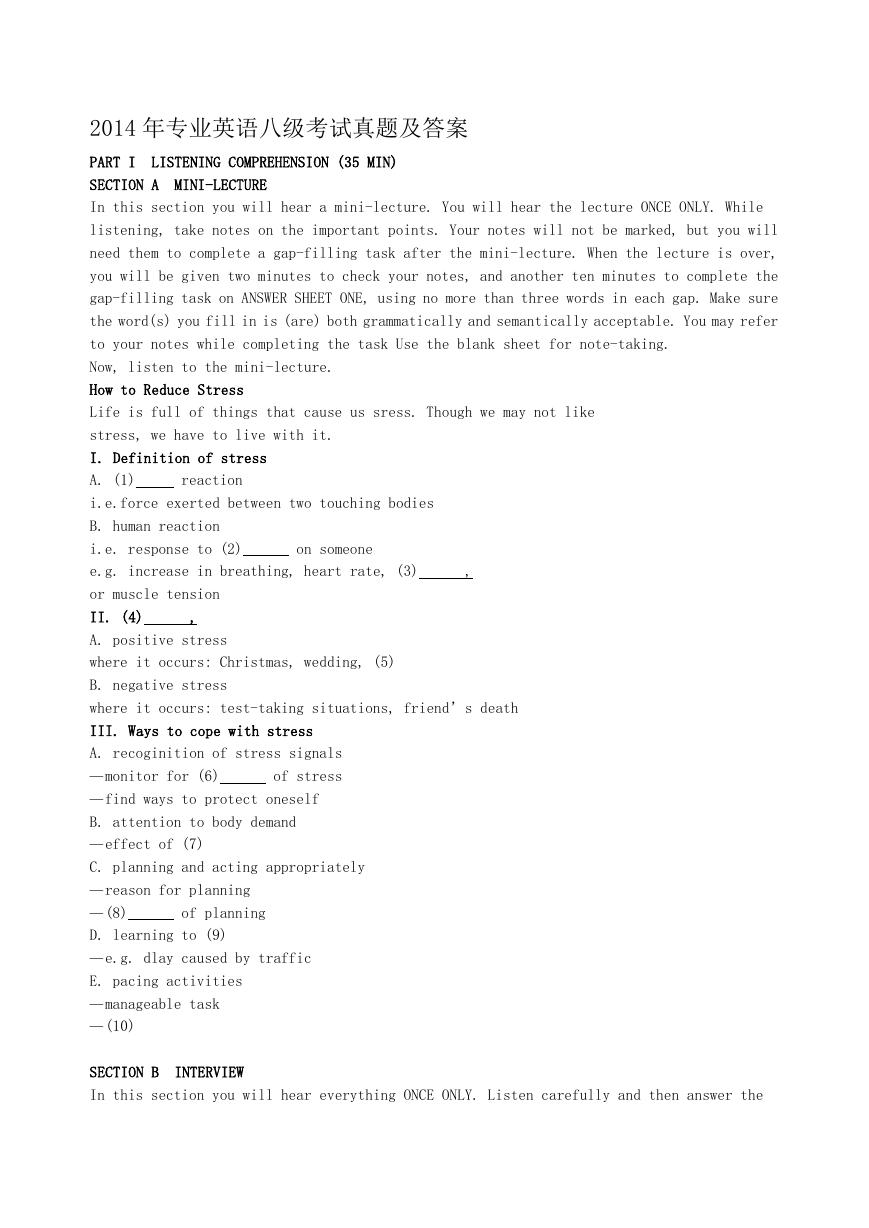















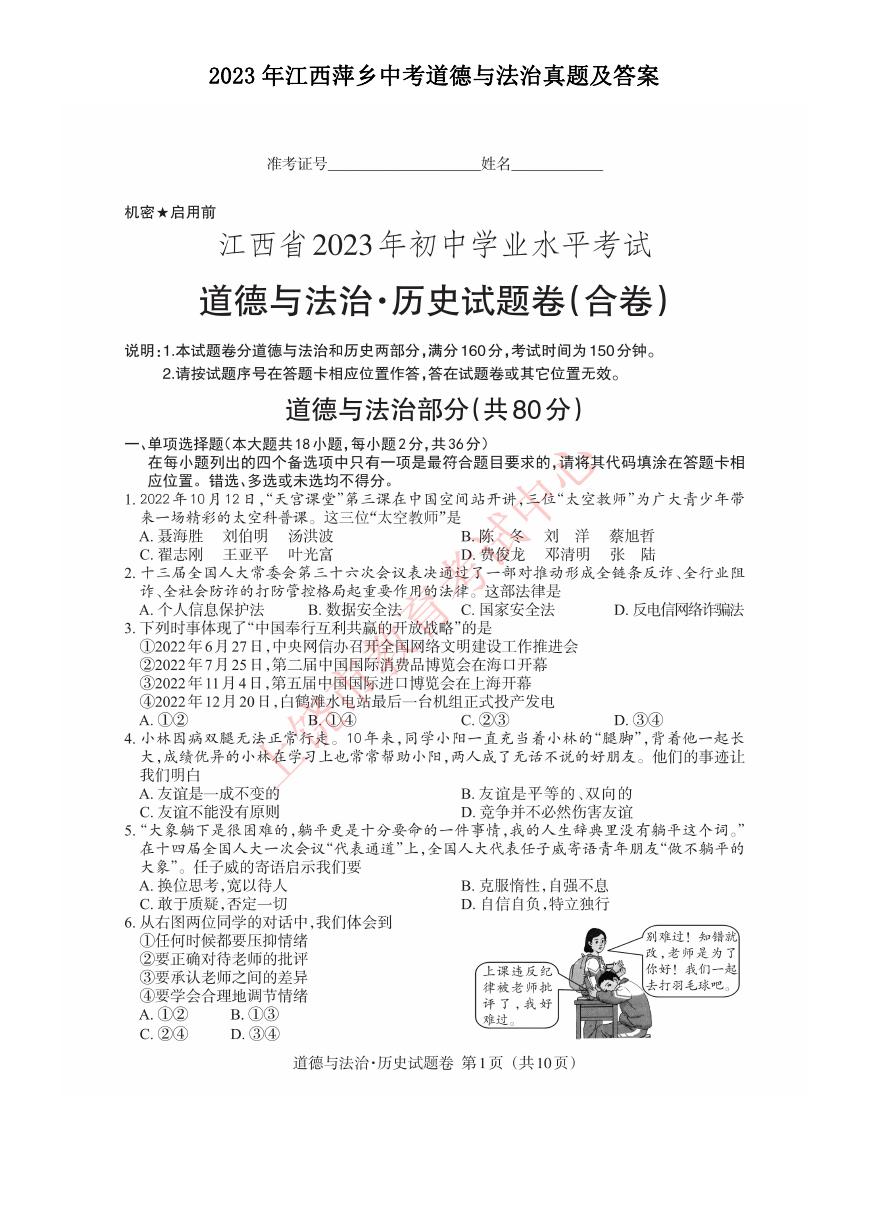 2023年江西萍乡中考道德与法治真题及答案.doc
2023年江西萍乡中考道德与法治真题及答案.doc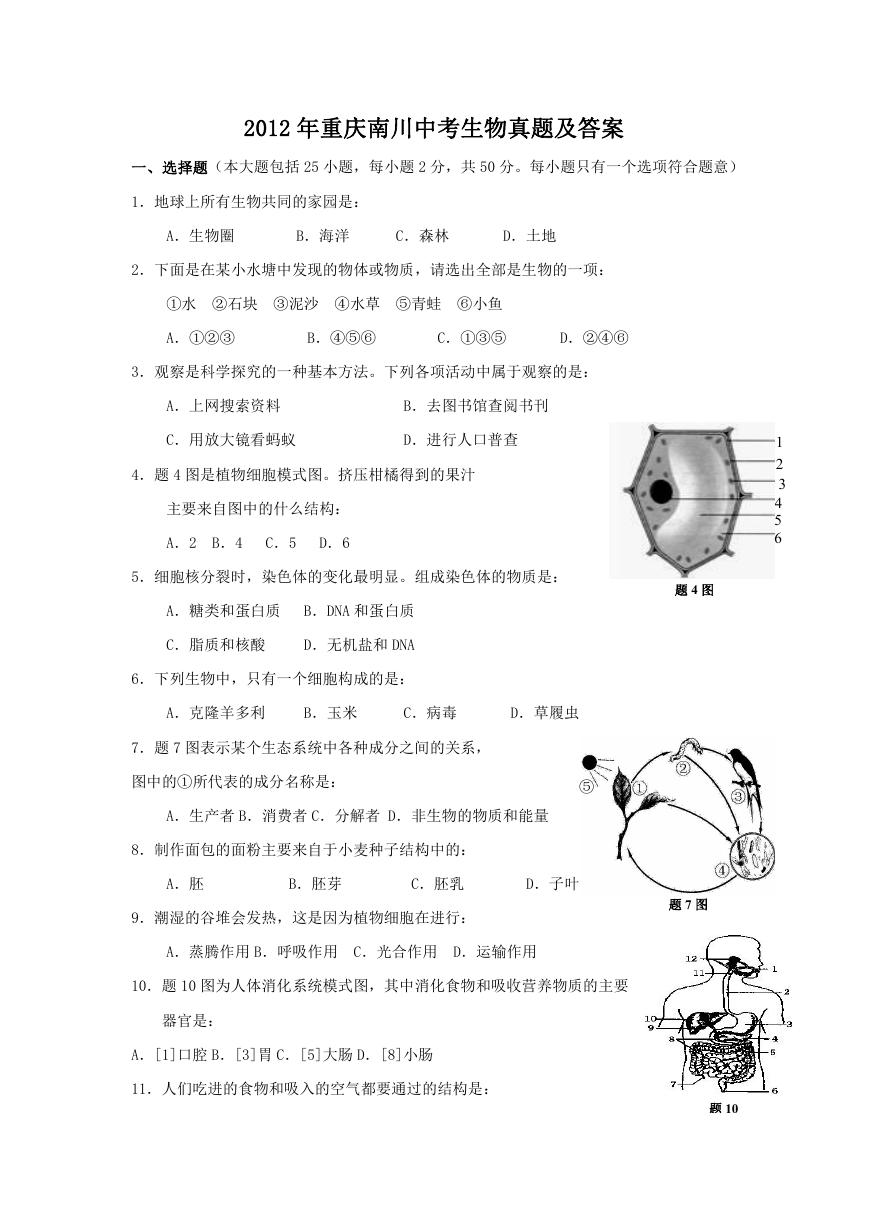 2012年重庆南川中考生物真题及答案.doc
2012年重庆南川中考生物真题及答案.doc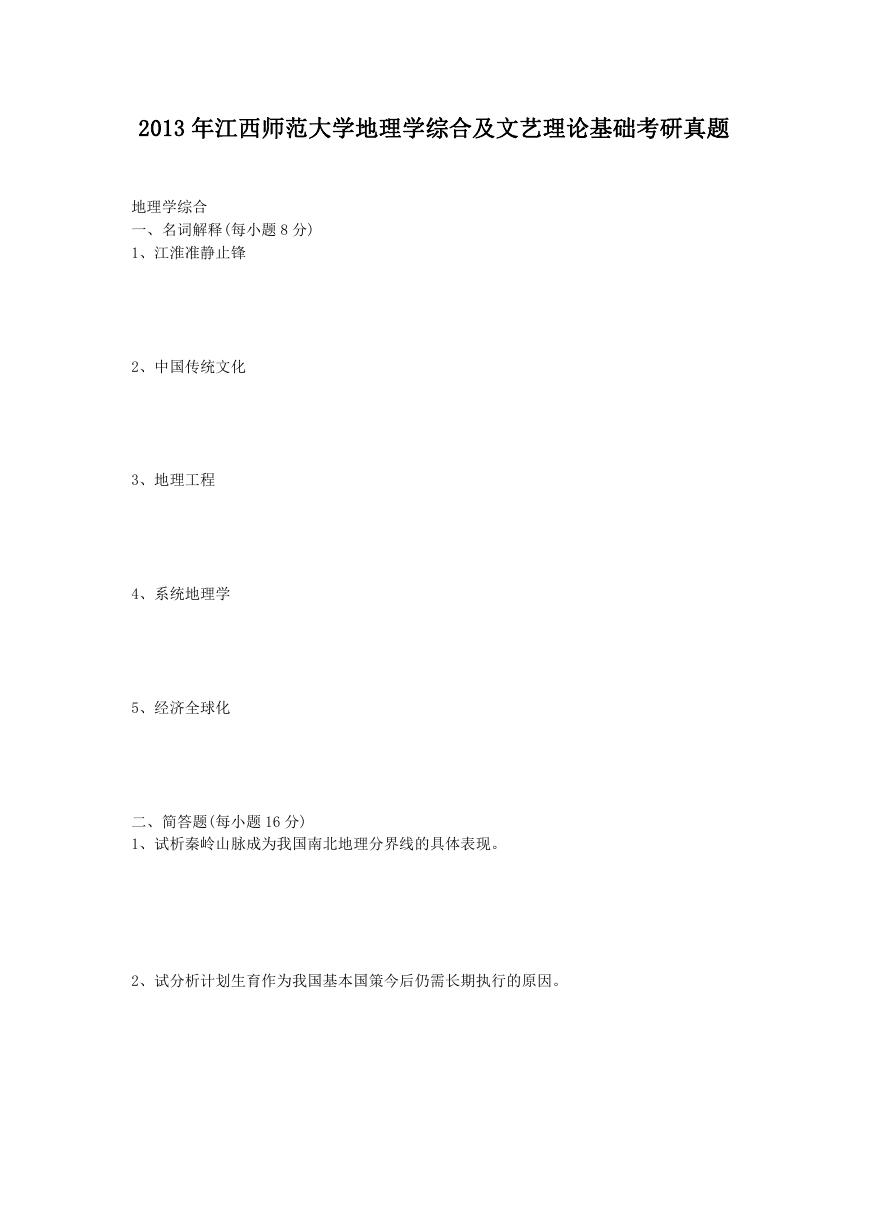 2013年江西师范大学地理学综合及文艺理论基础考研真题.doc
2013年江西师范大学地理学综合及文艺理论基础考研真题.doc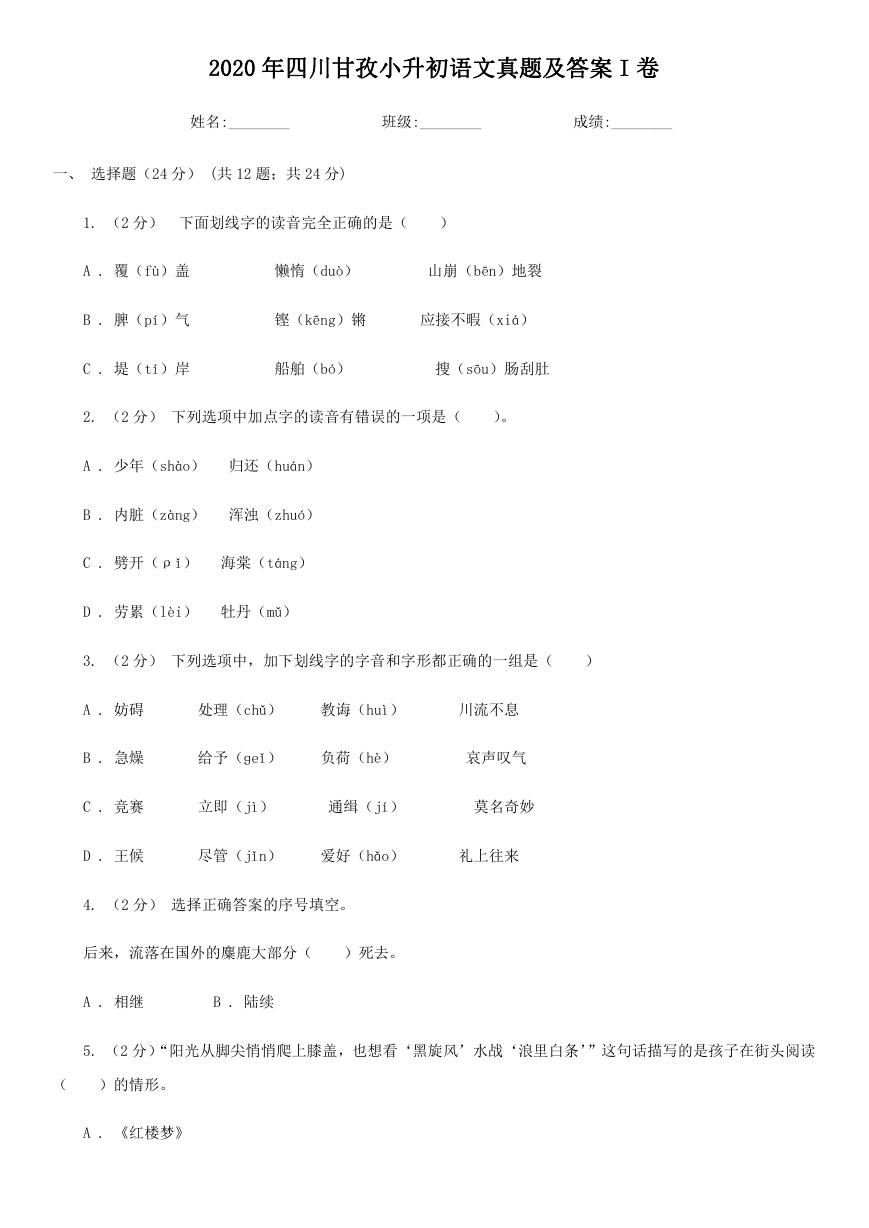 2020年四川甘孜小升初语文真题及答案I卷.doc
2020年四川甘孜小升初语文真题及答案I卷.doc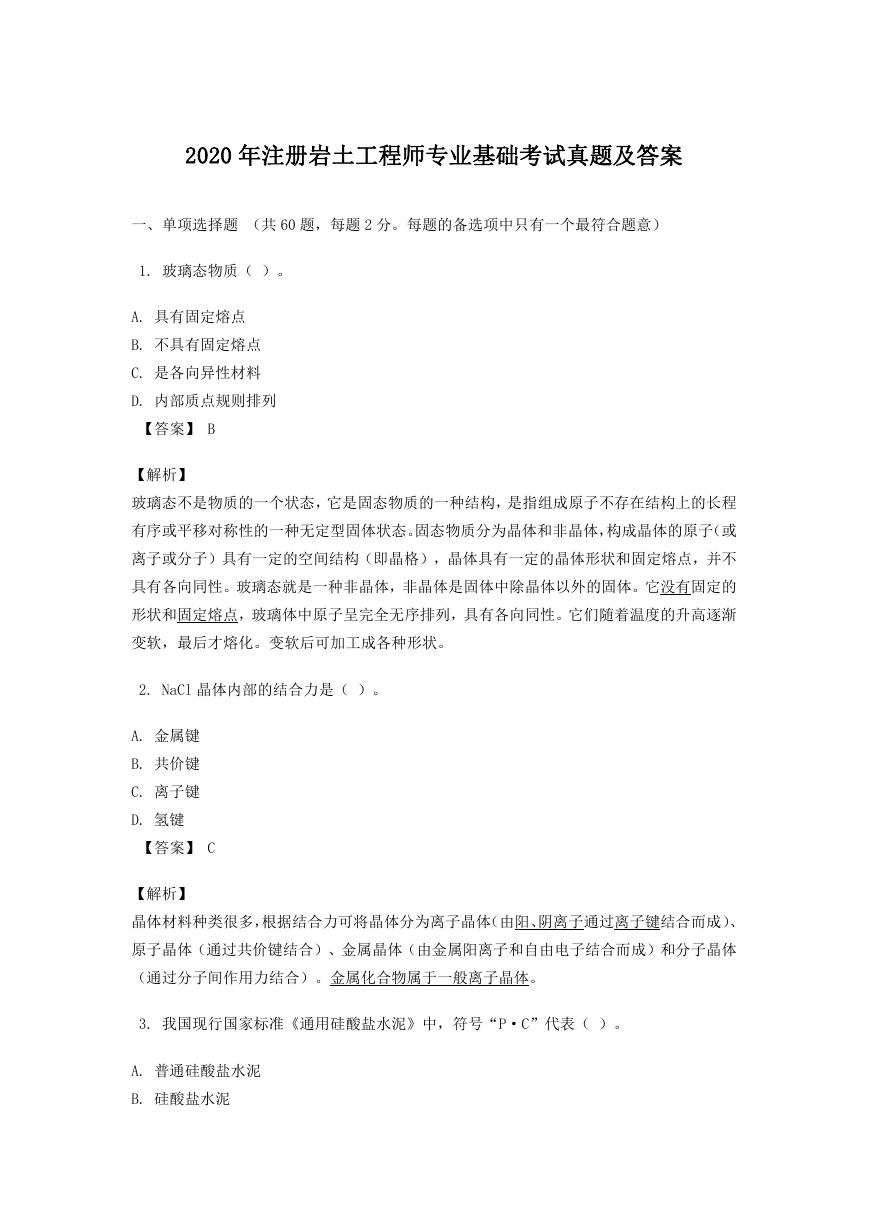 2020年注册岩土工程师专业基础考试真题及答案.doc
2020年注册岩土工程师专业基础考试真题及答案.doc 2023-2024学年福建省厦门市九年级上学期数学月考试题及答案.doc
2023-2024学年福建省厦门市九年级上学期数学月考试题及答案.doc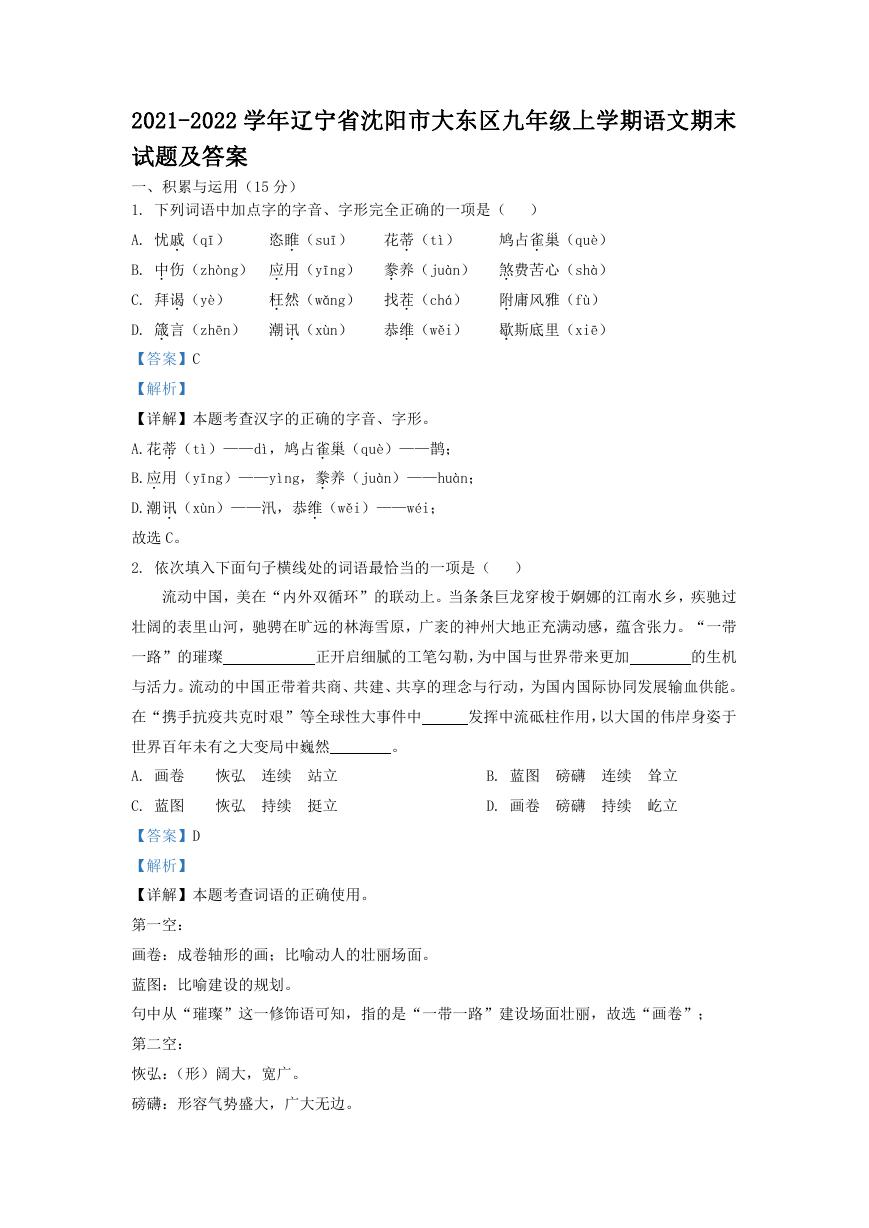 2021-2022学年辽宁省沈阳市大东区九年级上学期语文期末试题及答案.doc
2021-2022学年辽宁省沈阳市大东区九年级上学期语文期末试题及答案.doc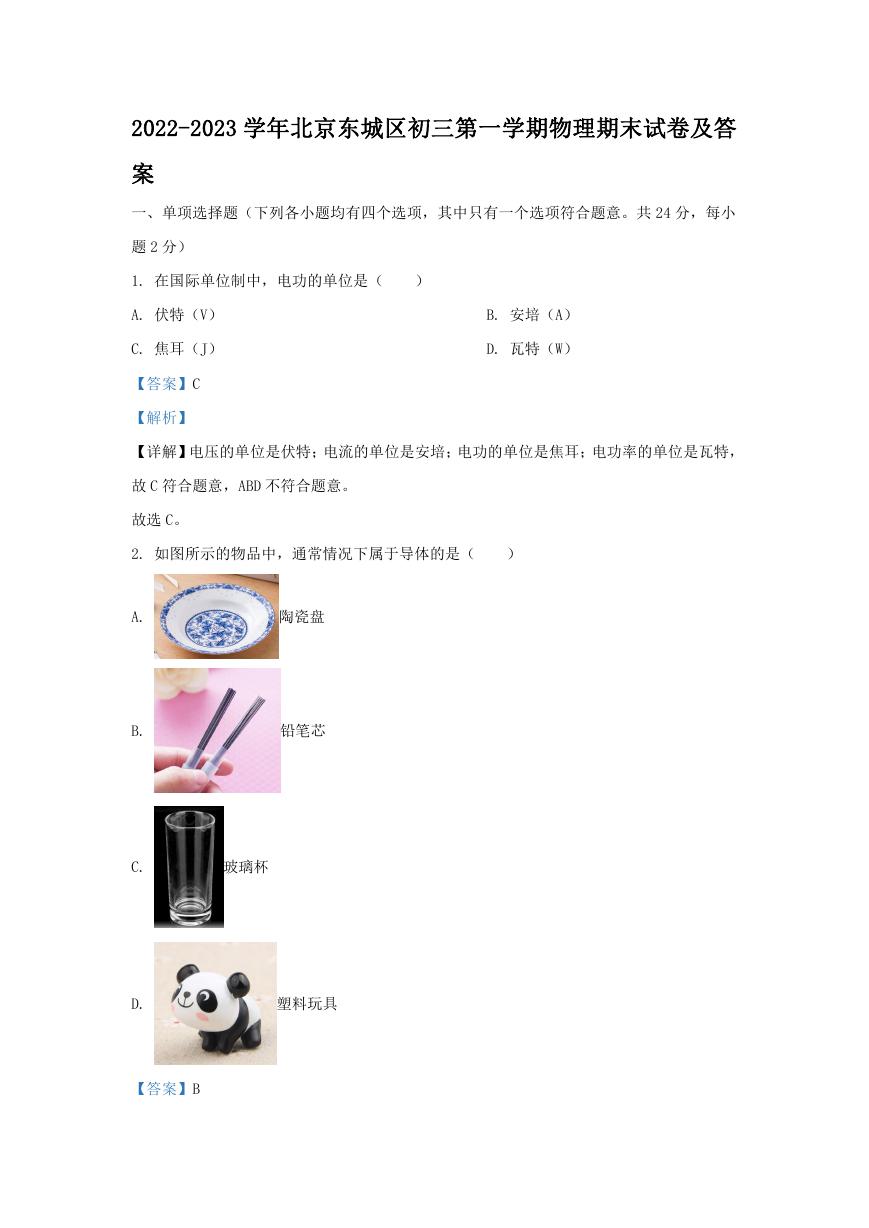 2022-2023学年北京东城区初三第一学期物理期末试卷及答案.doc
2022-2023学年北京东城区初三第一学期物理期末试卷及答案.doc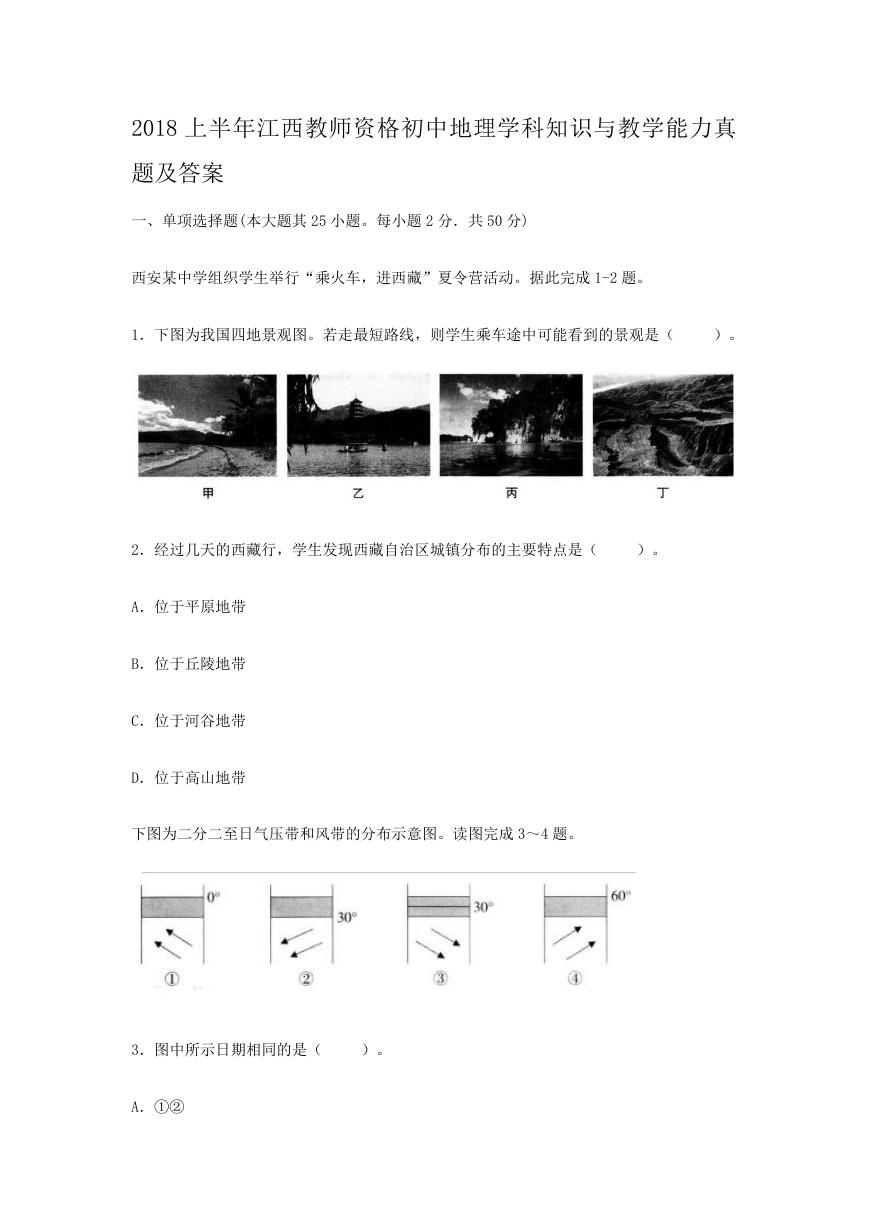 2018上半年江西教师资格初中地理学科知识与教学能力真题及答案.doc
2018上半年江西教师资格初中地理学科知识与教学能力真题及答案.doc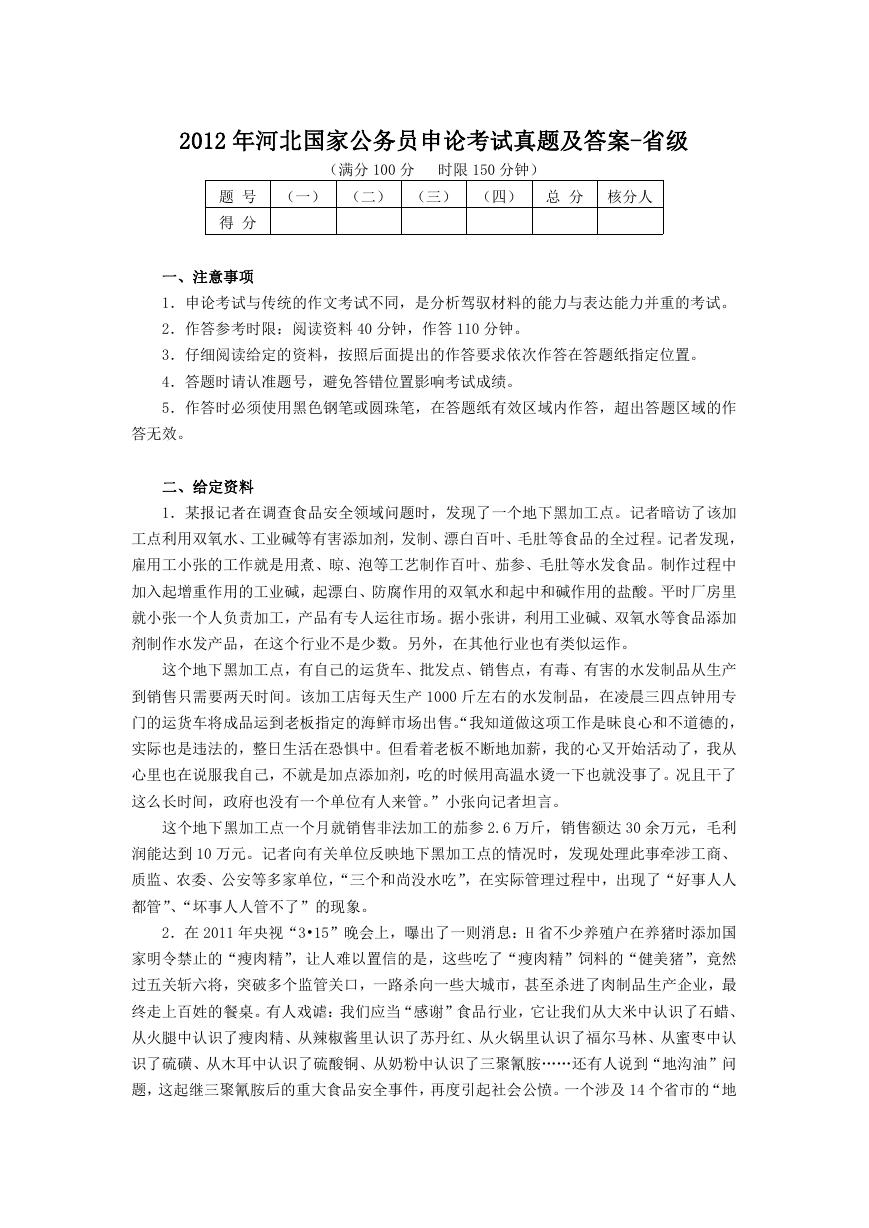 2012年河北国家公务员申论考试真题及答案-省级.doc
2012年河北国家公务员申论考试真题及答案-省级.doc 2020-2021学年江苏省扬州市江都区邵樊片九年级上学期数学第一次质量检测试题及答案.doc
2020-2021学年江苏省扬州市江都区邵樊片九年级上学期数学第一次质量检测试题及答案.doc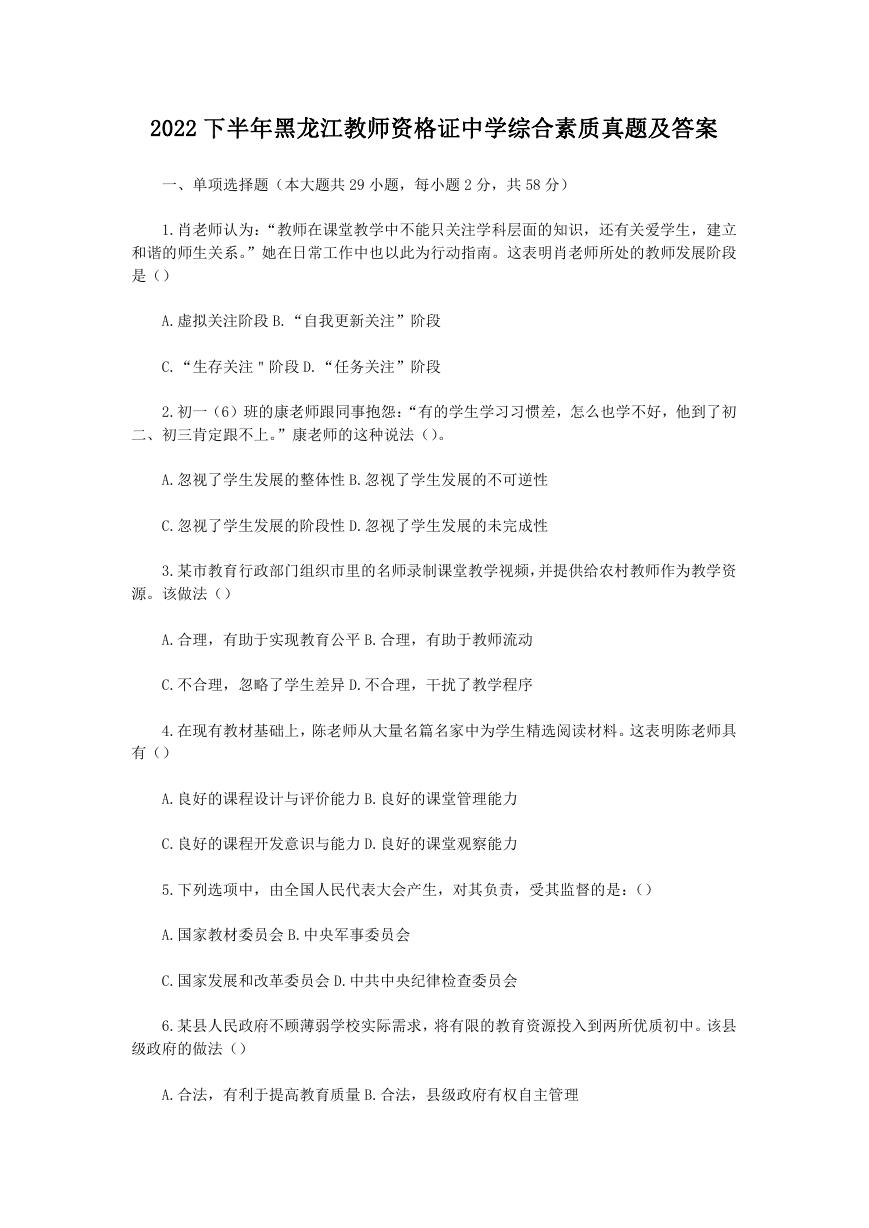 2022下半年黑龙江教师资格证中学综合素质真题及答案.doc
2022下半年黑龙江教师资格证中学综合素质真题及答案.doc